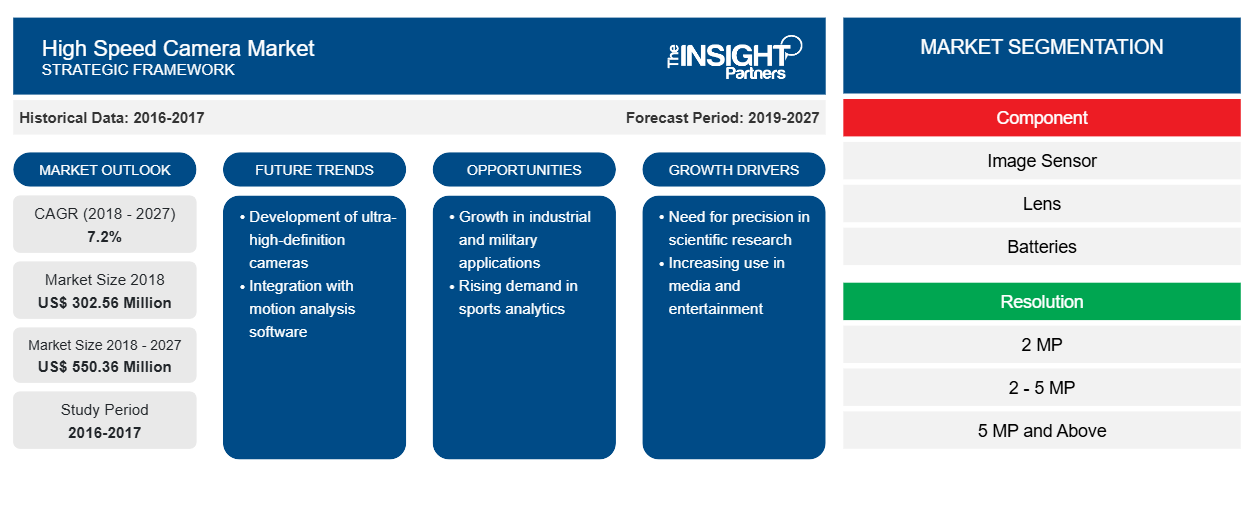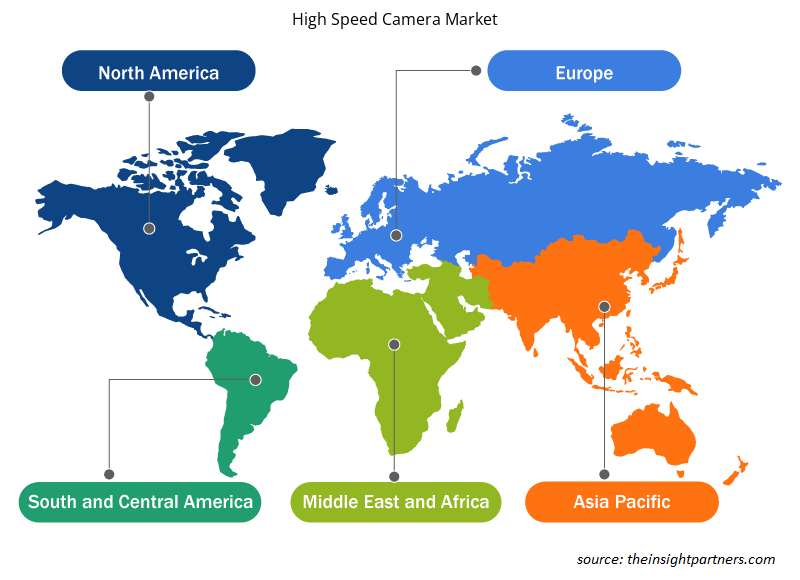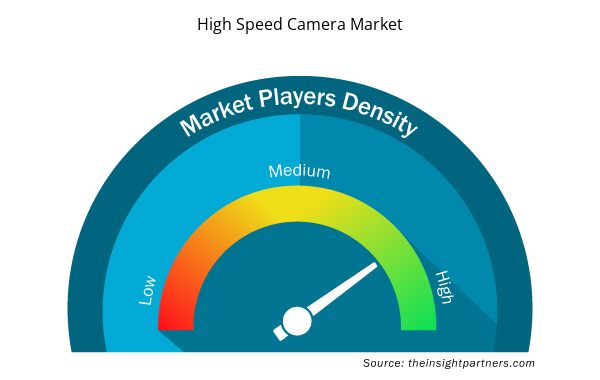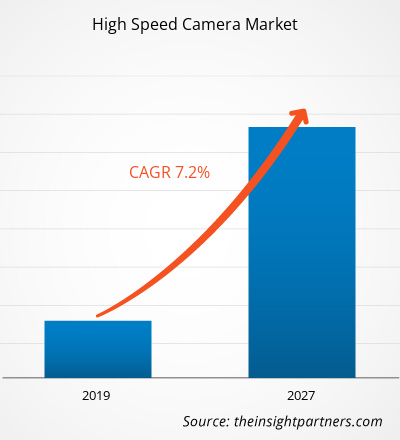The high speed camera market was valued at US$ 302.56 million in 2018 and is projected to reach US$ 550.36 million by 2027; it is expected to grow at a CAGR of 7.2% during 2019–2027.
High Speed camera are used for shooting slow motion videos. The camera takes thousands of burst images and compile them to create a smooth video. They are used to analyze events in slow motion and capture the effects which are invisible to naked eye. Advancements in high-speed sensor technology have presented the possibility for the creation of high-speed cameras. The more substantial resolution capacities mean a sharper image with less noise is possible, which can increase user's abilities to see aspects of an event that were not visible prior. The high-speed camera allows events too quick to see with the human eye to be analyzed and captured. To meet the demands of customers, along with several critical applications of high-speed cameras, had led to the development of high-speed digital imaging technologies since 1989.
To deliver slow-motion videos, it is obvious to use cameras that collect images that are a thousand times higher of the standard production frame rates, to allow the video to be slowed down further without diminishing quality. A high-speed camera is generally categorized into two types:
- Super motion or super slo-mo: cameras running at between two times (100~120 fps) and ten times (500~600fps) the standard frame rate
- Hyper motion: cameras running at from 1000 fps or more and recording in short bursts onto an internal camera memory.
The demand for high-speed camera is increasing. Various industries are opting for these cameras for better analyzing of events in slow motion. With the increasing demand, the production of the camera is also going to increase, which in turn is going to bring down the cost associated with high-speed camera components. Custom components are required for the manufacturing of a high-speed camera, which is entirely different from a consumer of a studio camera. The high shutter rate of these cameras demands custom image sensors, data storage, connectivity solutions, batteries, thermal management, faster image processors, and next-gen storage technologies. All these custom components incur an additional cost, which has hindered the market’s growth. However, with the rising demand across the globe from various industries is going to give rise to rising production. The reason, as mentioned earlier, is going to realize the economies of scale relativity, which in turn is going to reduce the high-speed camera’s price. Thus with the increased production of the camera, the economy of scale will come into play, which in turn is going to reduce the overall camera price. With price reduced, the demand for the high-speed camera is further set to increase.
Customize This Report To Suit Your Requirement
You will get customization on any report - free of charge - including parts of this report, or country-level analysis, Excel Data pack, as well as avail great offers and discounts for start-ups & universities
High Speed Camera Market: Strategic Insights

- Get Top Key Market Trends of this report.This FREE sample will include data analysis, ranging from market trends to estimates and forecasts.
You will get customization on any report - free of charge - including parts of this report, or country-level analysis, Excel Data pack, as well as avail great offers and discounts for start-ups & universities
High Speed Camera Market: Strategic Insights

- Get Top Key Market Trends of this report.This FREE sample will include data analysis, ranging from market trends to estimates and forecasts.
Market Insights–High Speed Camera Market
Increase In Resolution Is Going to Offer Higher Frame Rate in Even Higher Resolution
In recent times, high-speed cameras are available in a variety of resolutions. Usually, the resolutions are between 1 - 5 megapixels (MP). Higher resolutions are necessary when the field of view of the high-speed camera is vast, or when a least spatial resolution is expected because of a lot of granular details in the high-speed event that needs to be studied. It is universal that the greater the resolution of the camera, the weaker the maximum frame rate. With a 5 MP camera, the camera has five times more pixels to process than with a 1 MP camera. Therefore, it is not viable to achieve the same frame rates with a higher resolution camera as with a lower resolution camera. With the advancement n image sensor and image processor processing power, in the future it is possible to achieve the same frame rate of a 1 MP camera with a 5 MP camera. Thus, over the forecast period from 2019 – 2027, the advancement in technology is going to offer greater frame rate in higher resolutions.
Component Segment Insights
Based on component, the high-speed camera market is segmented into image sensor, lens, batteries, image processors, fans and cooling systems, memory systems and others. The Image Sensors segment is expected to hold the prime market share in the high speed camera market, owing to its wide component in businesses and enterprises. A high speed camera involves many critical components such as sensor, processor, lens, memory systems, fans and cooling systems, memory systems and a few others. Every high speed camera is reliable on these critical components for better results. The form of components varies with different types of variants of high speed cameras. High speed cameras are characterized by these components and they allow different levels of customization with respect to applications. High speed cameras components play a vital role in every industry wherein these products are deployed.
Resolution Segment Insights
Based on resolution, the high-speed camera market is bifurcated into 2 MP, 2 - 5 MP, 5 MP and above. Pixel resolution of the high-speed cameras is another important parameter to consider before purchasing it. The high-speed cameras are available in a variety of resolutions. Higher resolution cameras are choosing for applications where the field of view of the camera is large or when a very small spatial resolution is required as numerous fine details in the high-speed event.
Frame Rate Segment Insights
Based on resolution, the high-speed camera market is bifurcated into 1,000 - 5,000, 5,000 - 20,000, 20,000 - 100,000 and 100,000 and above. Frame rates are the primary factors for consideration while purchasing a high speed camera. Most high-speed cameras provide the ability to run at increasingly higher frame rates as the pixel resolution is reduced. However, the increased frame rate is not completely proportional to the reduction in resolution and typically comes with restrictions regarding the specific numbers of horizontal and/or vertical pixels to be selected with the reduced resolution. There is a very wide range of performance levels and a wide range of costs for high-speed cameras.
Application Segment Insights
Based on application, the high-speed camera market is bifurcated into automotive & transportation, industrial manufacturing, food & beverages, consumer electronics, media & entertainment, sports, healthcare and others. High speed cameras are significantly used in almost every industry for various applications. These systems provide powerful way of automatic quality assurance and high speed operations. The high speed cameras are majorly used in the automotive sector and the manufacturing sector. They act as useful tools in manufacturing based purposes as well as transportation and logistics services.
The market players focus on new product innovations and developments by integrating advanced technologies and features in their products to compete with the competitors.
2019:NEC Corporation developed a high-speed-camera object recognition in collaboration with partners, comprising Ishikawa Senoo Laboratory, The University of Tokyo, and Graduate School of Information Science and Technology. This camera uses artificial intelligence (AI) to instantaneously review large numbers of images captured by high-speed cameras operating at speeds of 1,000 frames per second.
2019:AOS Technologies released New Imaging Studio v4 with the features such as, Support M-VIT cameras, OSD Logo support, Auto download functionality, Resolution resizing function for Movie Export, Global Erase Buffer mode, and many others.
The Global High Speed Camera Market has been Segmented as Follows:
High Speed Camera Market Regional Insights
The regional trends and factors influencing the High Speed Camera Market throughout the forecast period have been thoroughly explained by the analysts at Insight Partners. This section also discusses High Speed Camera Market segments and geography across North America, Europe, Asia Pacific, Middle East and Africa, and South and Central America.

- Get the Regional Specific Data for High Speed Camera Market
High Speed Camera Market Report Scope
| Report Attribute | Details |
|---|---|
| Market size in 2018 | US$ 302.56 Million |
| Market Size by 2027 | US$ 550.36 Million |
| Global CAGR (2018 - 2027) | 7.2% |
| Historical Data | 2016-2017 |
| Forecast period | 2019-2027 |
| Segments Covered |
By Component
|
| Regions and Countries Covered | North America
|
| Market leaders and key company profiles |
High Speed Camera Market Players Density: Understanding Its Impact on Business Dynamics
The High Speed Camera Market is growing rapidly, driven by increasing end-user demand due to factors such as evolving consumer preferences, technological advancements, and greater awareness of the product's benefits. As demand rises, businesses are expanding their offerings, innovating to meet consumer needs, and capitalizing on emerging trends, which further fuels market growth.
Market players density refers to the distribution of firms or companies operating within a particular market or industry. It indicates how many competitors (market players) are present in a given market space relative to its size or total market value.
Major Companies operating in the High Speed Camera Market are:
- Sanstreak Corp
- Mega Speed Corporation
- The Slow Motion Camera Company
- AOS Technologies AG
- Fastec Imaging
Disclaimer: The companies listed above are not ranked in any particular order.

- Get the High Speed Camera Market top key players overview
Global High Speed Camera Market – By Component
- Image Sensors
- Lens
- Batteries
- Image Processors
- Fans and Cooling System
- Memory Systems
- Others
Global High Speed Camera Market – By Resolution
- 2 MP
- 2 – 5 MP
- 5 MP and Above
Global High Speed Camera Market – By Frame Rate
- 1,000 – 5,000
- 5,000 – 20,000
- 20,000 – 100,000
- 100,000 and Above
Global High Speed Camera Market – By Application
- Automotive and Transportation
- Industrial Manufacturing
- Consumer Electronics
- Media and Entertainment
- Sports
- Healthcare
- Others
Global High Speed Camera Market – By Geography
North America
- U.S.
- Canada
- Mexico
Europe
- France
- Germany
- Italy
- UK
- Russia
- Rest of Europe
Asia Pacific (APAC)
- China
- South Korea
- India
- Japan
- Australia
- Rest of APAC
Middle EAST & Africa (MEA)
- Saudi Arabia
- UAE
- South Africa
- Rest of Middle East & Africa
South America
- Brazil
- Argentina
- Rest of South America
Global High Speed Camera Market - Company Profiles
- AOS Technologies AG
- Edgertronic
- Fastec Imaging
- Integrated Design Tools
- Mega Speed USA
- Mikrotron GmBH
- NAC Image Technology
- NEC Corporation
- Optronis GmBH
- PCO AG
- Photron
- The Slow Motion Camera Company
- Vision Research
- Historical Analysis (2 Years), Base Year, Forecast (7 Years) with CAGR
- PEST and SWOT Analysis
- Market Size Value / Volume - Global, Regional, Country
- Industry and Competitive Landscape
- Excel Dataset


- Biopharmaceutical Contract Manufacturing Market
- Data Annotation Tools Market
- Batter and Breader Premixes Market
- Virtual Pipeline Systems Market
- Electronic Signature Software Market
- Smart Grid Sensors Market
- Fishing Equipment Market
- Environmental Consulting Service Market
- Aerosol Paints Market
- Mail Order Pharmacy Market

Report Coverage
Revenue forecast, Company Analysis, Industry landscape, Growth factors, and Trends

Segment Covered
Component ; by Resolution , by Frame Rate , and Application

Regional Scope
North America, Europe, Asia Pacific, Middle East & Africa, South & Central America

Country Scope
US, Canada, Mexico, UK, Germany, Spain, Italy, France, India, China, Japan, South Korea, Australia, UAE, Saudi Arabia, South Africa, Brazil, Argentina
Trends and growth analysis reports related to Electronics and Semiconductor : READ MORE..
The List of Companies - High Speed Camera Market
- Sanstreak Corp
- Mega Speed Corporation
- The Slow Motion Camera Company
- AOS Technologies AG
- Fastec Imaging
- Integrated Design Tools Inc
- Mikrotron GmbH
- nac Image Technology, Inc.
- NEC Corporation
- Optronis GmbH

 Get Free Sample For
Get Free Sample For